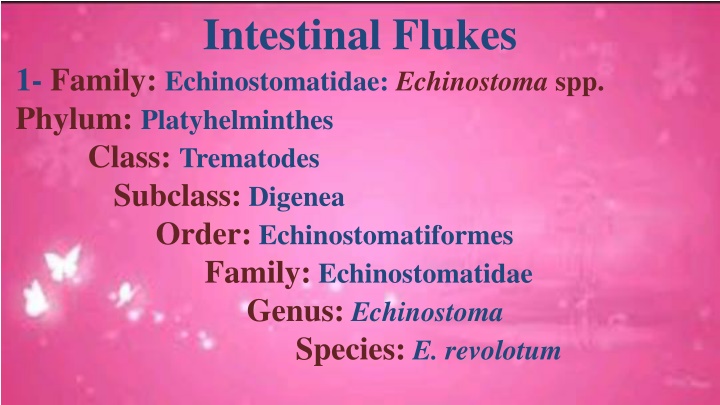
Intestinal Flukes: Echinostoma and Paramphistomum Species
Learn about intestinal flukes belonging to the Family Echinostomatidae and Order Echinostomatiformes, as well as Paramphistomiformes. Explore their life cycles, hosts, sites of infection, and typical species, along with treatment options for infected animals.
Download Presentation

Please find below an Image/Link to download the presentation.
The content on the website is provided AS IS for your information and personal use only. It may not be sold, licensed, or shared on other websites without obtaining consent from the author. If you encounter any issues during the download, it is possible that the publisher has removed the file from their server.
You are allowed to download the files provided on this website for personal or commercial use, subject to the condition that they are used lawfully. All files are the property of their respective owners.
The content on the website is provided AS IS for your information and personal use only. It may not be sold, licensed, or shared on other websites without obtaining consent from the author.
E N D
Presentation Transcript
Intestinal Flukes 1- Family: Echinostomatidae: Echinostoma spp. Phylum: Platyhelminthes Class: Trematodes Subclass: Digenea Order: Echinostomatiformes Family: Echinostomatidae Genus: Echinostoma Species: E. revolotum
Intermediate host: First: snails, Second: Fishes, tadpoles, Planaria Final host: Birds Site of Infection: Intestine Tend to be relatively non-host specific in semi-aquatic vertebrates. Many species elongate; anterior sucker and large acetabulum anterior, 27-51 circumoral collar of spines, depending upon species Life-cycle Adults in gut, eggs passed in feces, hatch; miricidia penetrate snails , for instance, sporocyst; two redia, cercaria, metacercaria in molluscs, planaria, fish, tadpoles, etc. eaten by definitive host
Typical species A.Echinostoma caproni (in mammalian and avian hosts; Africa) B.Echinostoma trivolvus (in mammalian and avian hosts; North America) C.Echinostoma revolutum ( in mammals and birds; Europe and Asia)
Order: Paramphistomiformes This order often placed as a superfamily of the order Echinostomatiformes. Composed of amphistomes (acetabulum at or near posterior end). Usually thick, fleshy worms. Ovary usually post-testicular 2- Family: Paramphistomidae: Paramphistomum cervi Phylum: Platyhelminthes Class: Trematodes Subclass: Digenea Order: Paramphistomatiforms Family: Paramphistomidae Genus: Paramphistomum sp.
Pathogenic; in large numbers can cause intestinal ulceration and death; secondary bacterial infections Life-cycle Adults in rumen, eggs out with feces, mature in water to miricidium hatches; penetrates multiple genera of snail hosts, one sporocyst and two redial generations, cercaria encyst on aquatic vegetation, eaten by herbivore, excyst in duodenum; penetrate gut; migrate through tissues to abomasum, enter lumen and migrate anteriorly to rumen, mature in 2-4 months.
Treatment: It can be use the drug Hexachloroethan or Pentonine for treat the infected animals as 180 gr./kg. body weight, and using mollescicide as a chemical control to kill the snails ( intermediate hosts).
